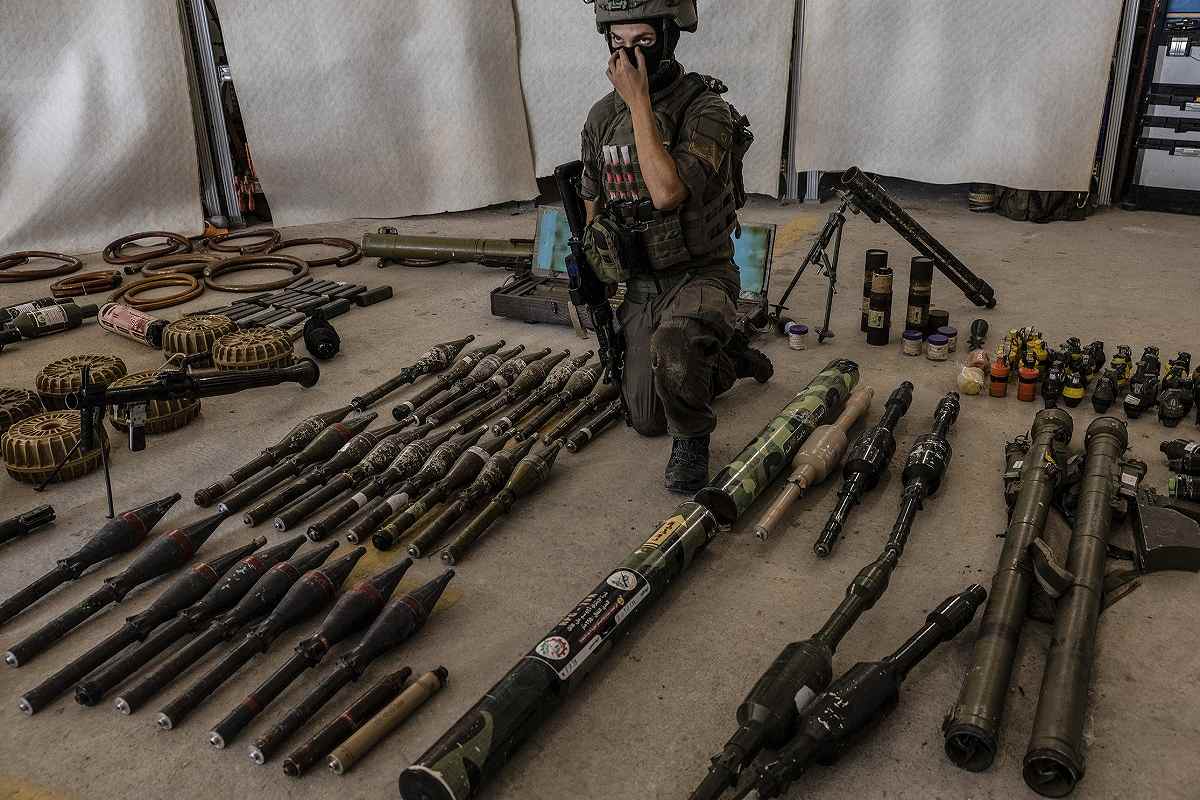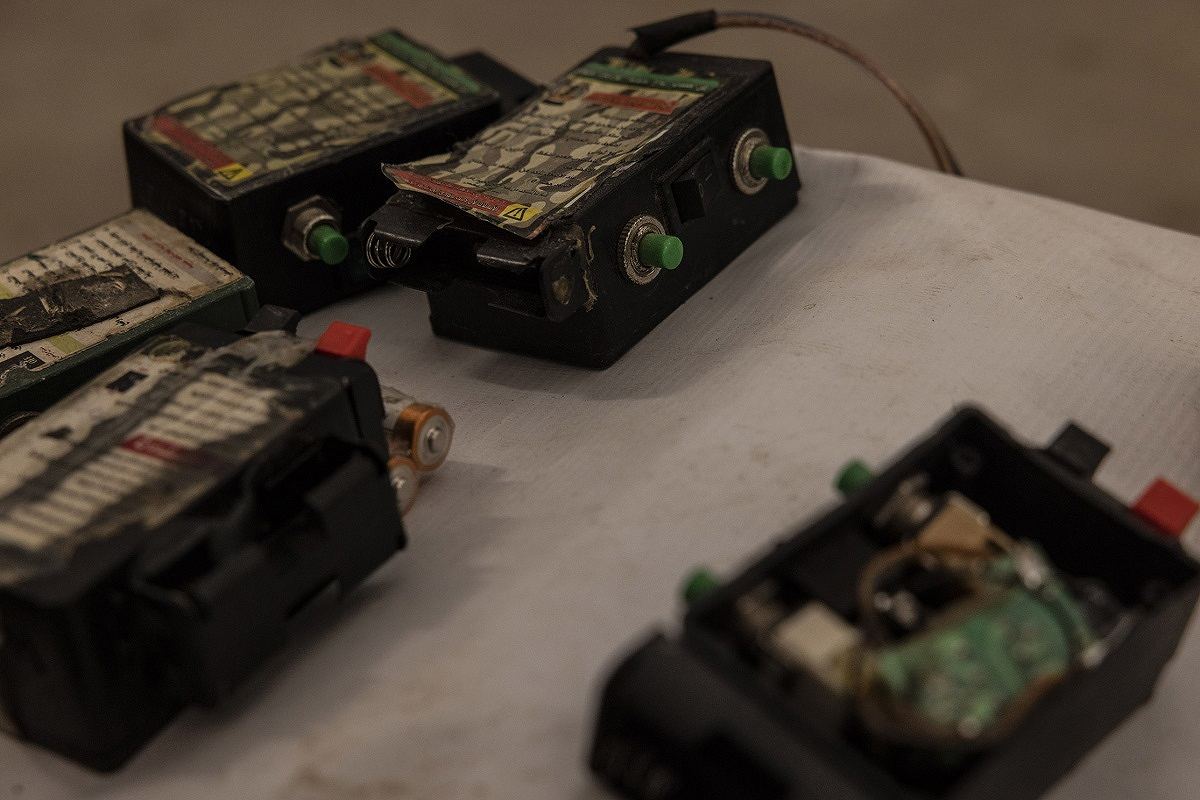
An Israeli officer, identified as Major G. under briefing ground rules, shows a cache of confiscated Hamas weapons at a military base in southern Israel on Oct. 20, 2023.
12:01 JST, October 22, 2023
ASHKELON, Israel – A Hamas field manual obtained by The Washington Post and other documents found in the wake of the group’s brutal attack on Israel two weeks ago illustrate some of its military capabilities and preparations for close-in, bloody killing.
The manual, dated last year and found on the body of a Hamas fighter, lists instructions on operating certain weapons, identifies vulnerabilities in Israeli military equipment and offers tips on killing with a knife. The document appears to have been prepared for different units of Hamas’s elite Izzedine al-Qassam Brigades, including anti-armor, engineering, sniper, infantry and tunnel specialists as well as what the booklet describes as “shock troops.”
“This is a secret military document,” the first page begins. “It should be kept in a safe place. It is forbidden to move with it except when there are orders.”
On its back cover is a picture of the Palestinian sheikh Abdullah Azzam, a mentor of Osama bin Laden. “If this is their source of inspiration, and this is the figure, the symbol, they are looking at, I understand something more about their behavior on Oct. 7,” said Michael Milshtein, a former head of the Palestinian department in Israeli military intelligence, referring to the date of the attack that left 1,400 Israelis dead. Milshtein examined the field manual at the request of The Post.
Experts, including Milshtein, said the manual appeared to be genuine and matches a cache of other documents gathered by Israeli forces and first responders following the attack. The Israeli prime minister’s office has verified 17 pages of documents for The Post. Some documents, including the field manual, were not provided for verification because of identifying marks that could identify who first found them and gave them to The Post.
Others Hamas documents have included maps and detailed plans for attacks on several individual kibbutzim around Gaza, including the intention to kill and kidnap civilians.
The document obtained by The Post provided guidance on operating weapons that they are known to have carried and also offered detailed descriptions on the vulnerabilities of Israeli tanks and armored vehicles. Included, for instance, are instructions for using North Korean F-7 rocket-propelled grenades, which Pyongyang has denied supplying to Hamas. Around 50 of the high-explosive munitions were found by Israeli troops following the attacks, according to the military, which has displayed some of the materiel it found.
Hamas officials in Gaza and Beirut did not respond to requests for comment.
Hamas’s secretive military wing al-Qassam is estimated to have a built a force of anywhere between 15,000 and 40,000 combat-ready fighters – 1,200 of whom it has said were involved in the Oct. 7 attack.
In earlier years when tunnels were open to Egypt, Hamas could easily smuggle in explosives and rockets to Gaza, said Mkhaimar Abusada, an analyst at Gaza’s Al-Azhar University. But Egyptian President Abdel Fatah El-Sisi has clamped down on smuggling routes.
“Honestly I don’t know how they have kept up their ability to build this military capability,” Abusada said, noting the security perimeter around Gaza. Members of al-Qassam’s elite Nukhba special forces that spearheaded the assault are known to have been trained in Iran and have returned to Gaza to train others, he said.
Militants used paragliders, motorbikes and trucks to cross the border fence from Gaza into Israel, and small specialized units attacked Israeli communities, in line with the instructions in the handbook.
“We saw they are working as professional troops,” said Maj. G, a commander of the Israeli Institute for Weapons Research on Friday, as he displayed weapons that had been seized from Hamas. The major could only be identified by his rank and first name under rules set by the Israeli briefers. “They worked very specifically. It was very organized. One vehicle is IED, one vehicle was RPGs, one vehicle was a command team.”
The instructions for “shock troops” also included the best places to stab someone, according to the field manual obtained by The Post. The “neck in the collarbone area,” “spine” and “underarms” are listed.
Aymenn al-Tamimi, an expert with the Middle East Forum who has extensively studied documents recovered from battlefields in Iraq and Syria agreed that it appeared genuine. “It wouldn’t be surprising for documents like this to be in the possession of fighters,” he said.
The Israeli military says hundreds of documents and other material have been collected by the Intelligence Directorate and the Yahalom combat engineering unit, including Hamas cellphones, communication equipment, cameras and intelligence reports.
Many documents have emerged in a Telegram channel called South First Responders, which compiles evidence gathered in the aftermath of the attacks by those clearing the areas. The group declines to answer questions on its methods for gathering documents and material – citing risks to sources.
Those who have worked to remove the bodies of hundreds of Palestinian militants killed in the assault say that corpses are first checked over by bomb squads to make sure there are no hidden explosives.
“They came with everything, fully equipped, with documents, maps and instructions,” said Yossi Landau, a front-line responder with the Zaka medical organization, which has been working to remove bodies.
One 14-page document partially posted by South First Responders and verified by Israeli authorities outlined attack plans for Mefalsim, a small kibbutz of 1,000 people that managed to escape relatively unscathed from the attack. Kibbutz security fought off a group of around 30 militants armed with grenades and AK-47s at the front gate.
The document details the size of the Kibbutz security team, the number of minutes it would take to travel between various points in the community and the goal to “take soldiers and civilians as prisoners and hostages and negotiate their release.”
According to four additional pages obtained by The Post, the team at the front gate was supposed to distract the Kibbutz security force while a Hamas explosives unit blew a hole in the back gate.
“The group keeps the Kibbutz busy until the rest of the forces arrive,” the planning document said. But the reinforcements never arrived, according to those that fought in the Kibbutz.
“They knew where the gates were, they knew where the generators were to cut the electricity,” said Yarden Reskin, a landscape architect and volunteer on the security team at the kibbutz. Looking at the attack plans, and the death toll in surrounding communities: “We do feel like we had a lot of luck,” he said. “We did our part, we did it good, but we had a lot of luck.”

Detonators to trigger explosive devices were among a cache of Hamas weapons shown at a military base in southern Israel on Oct. 20, 2023.
"News Services" POPULAR ARTICLE
-

American Playwright Jeremy O. Harris Arrested in Japan on Alleged Drug Smuggling
-

Japan’s Nikkei Stock Average as JGB Yields, Yen Rise on Rate-Hike Bets
-

Japan’s Nikkei Stock Average Licks Wounds after Selloff Sparked by BOJ Hike Bets (UPDATE 1)
-

Japanese Bond Yields Zoom, Stocks Slide as Rate Hike Looms
-

Japan’s Nikkei Stock Average Buoyed by Stable Yen; SoftBank’s Slide Caps Gains (UPDATE 1)
JN ACCESS RANKING
-

Keidanren Chairman Yoshinobu Tsutsui Visits Kashiwazaki-Kariwa Nuclear Power Plant; Inspects New Emergency Safety System
-

Imports of Rare Earths from China Facing Delays, May Be Caused by Deterioration of Japan-China Relations
-

University of Tokyo Professor Discusses Japanese Economic Security in Interview Ahead of Forum
-

Japan Pulls out of Vietnam Nuclear Project, Complicating Hanoi’s Power Plans
-

Govt Aims to Expand NISA Program Lineup, Abolish Age Restriction



















